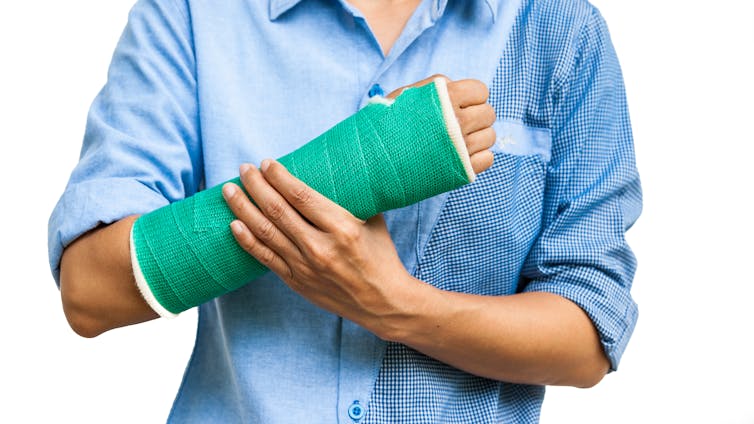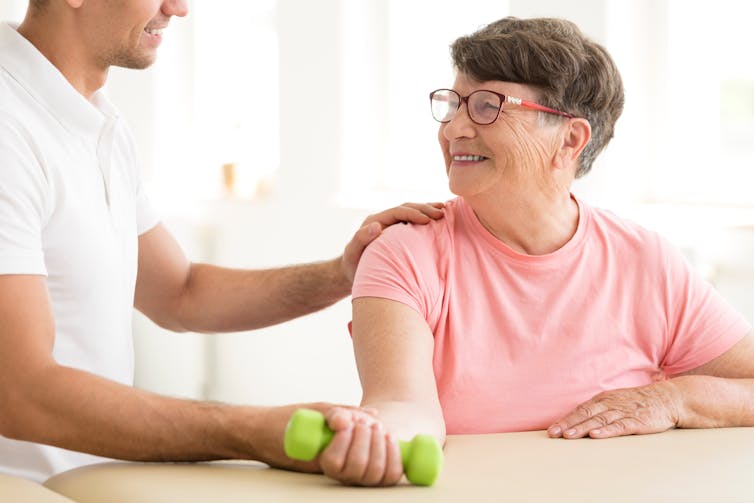Broke your arm? Exercise the other one to strengthen it…
/Broke your arm? Exercise the other one to strengthen it...

If you have ever broken an arm and had to wear a cast or splint for a few weeks, you will be familiar with the alarming loss of muscle and uneasy feeling of weakness experienced after removing your cast.
Most people do not do much exercise while a broken arm is healing and can struggle with this loss of muscle, known as “atrophy,” and weakness for many weeks after the injury.
A new study published recently in the Journal of Applied Physiology, conducted in my lab by graduate student Justin Andrushko, suggests an effective strategy to offset muscle weakness might be to exercise the other arm.
We recruited a group of 16 college students to wear casts on their left wrists for four weeks. Half of these students exercised their right arm aggressively three days per week using a type of training known as “eccentric training” — which lengthens the muscle during contraction, and is quite effective for building muscle and enhancing strength.
Before and after the study period, we measured wrist strength in several different ways and quantified muscle volume using a Computed Tomography (CT) scan of the forearm. As expected, those students who did not train lost about 20 per cent of their strength and about three per cent of their muscle volume after four weeks.
Remarkably, the students who trained their opposite wrist completely preserved both the strength and muscle volume in the left, immobilized arm. This research has received a lot of attention.
Possible ‘mirror’ contractions
The phenomenon that creates the effect is known as “cross-education,” and has been documented for over a century, but the new study is one of just a handful to measure the effect when the opposite limb is immobilized.
We are the first to examine the effects using CT scans to measure muscle volume, and to measure the strength of multiple muscle groups in both arms (i.e. wrist flexors and extensors).
It turns out that the effect appears to be quite specific: training of the right wrist flexors preserved the left wrist flexors, but not the extensor muscles.

We do not fully understand what causes the effect. Most of the published work points towards changes in the nervous system relating to how the sides of the brain share information, or how they adapt together after training one arm. However, we are fascinated with the muscle size preservation effects.
Unfortunately, the study did not take detailed measures of anything inside the muscle. We suspect there could be some yet unknown connection between nervous system changes and the balance of muscle protein.
One theory is that there are small contractions, known as “mirror” contractions, under the cast while training the opposite side. We measured these contractions and they are very small — perhaps too small to preserve the muscle — but they are present. We need to do more research to understand the role of these small contractions in relation to prevention of atrophy.
Consider training the opposite limb
Although the results are exciting, we caution that the study was a controlled lab experiment involving young healthy volunteers without a real injury.
More work in clinical settings is needed before any changes to standard rehabilitation practices can be discussed.
There have been a few clinical studies already published — about wrist fracture and recovery from stroke and knee surgery — with promising results. The clinical studies seem more positive for fracture and stroke recovery and less so after knee surgeries.
Lab-controlled studies like the one we conducted are important to understand the underlying mechanisms of the effect, and to maximize its potential in future clinical work.
While more work in clinical settings is certainly needed, we can still recommend that if you ever experience a limb fracture, you might consider training your opposite limb. As with many types of exercise training, the risk of this approach is quite low and could have important benefits.![]()
Jonathan Farthing, Associate Professor, College of Kinesiology, University of Saskatchewan and Justin Andrushko, PhD Student, University of Saskatchewan
This article is republished from The Conversation under a Creative Commons license. Read the original article.

